ZHCSBY9G July 2013 – June 2021 TPS54561
PRODUCTION DATA
- 1 特性
- 2 应用
- 3 说明
- 4 Revision History
- 5 Pin Configuration and Functions
- 6 Specifications
-
7 Detailed Description
- 7.1 Overview
- 7.2 Functional Block Diagram
- 7.3
Feature Description
- 7.3.1 Fixed Frequency PWM Control
- 7.3.2 Slope Compensation Output Current
- 7.3.3 Pulse Skip Eco-mode
- 7.3.4 Low Dropout Operation and Bootstrap Voltage (BOOT)
- 7.3.5 Error Amplifier
- 7.3.6 Adjusting the Output Voltage
- 7.3.7 Enable and Adjusting Undervoltage Lockout
- 7.3.8 Soft Start/Tracking Pin (SS/TR)
- 7.3.9 Sequencing
- 7.3.10 Constant Switching Frequency and Timing Resistor (RT/CLK) Pin)
- 7.3.11 Maximum Switching Frequency
- 7.3.12 Synchronization to RT/CLK Pin
- 7.3.13 Accurate Current Limit Operation
- 7.3.14 Power Good (PWRGD Pin)
- 7.3.15 Overvoltage Protection
- 7.3.16 Thermal Shutdown
- 7.3.17 Small Signal Model for Loop Response
- 7.3.18 Simple Small Signal Model for Peak Current Mode Control
- 7.3.19 Small Signal Model for Frequency Compensation
- 7.4 Device Functional Modes
-
8 Application and Implementation
- 8.1 Application Information
- 8.2
Typical Applications
- 8.2.1
Buck Converter for 7-V to 60-V Input to 5-V at 5-A Output
- 8.2.1.1 Design Requirements
- 8.2.1.2
Detailed Design Procedure
- 8.2.1.2.1 Custom Design with WEBENCH® Tools
- 8.2.1.2.2 Selecting the Switching Frequency
- 8.2.1.2.3 Output Inductor Selection (LO)
- 8.2.1.2.4 Output Capacitor
- 8.2.1.2.5 Catch Diode
- 8.2.1.2.6 Input Capacitor
- 8.2.1.2.7 Slow Start Capacitor
- 8.2.1.2.8 Bootstrap Capacitor Selection
- 8.2.1.2.9 Undervoltage Lockout Set Point
- 8.2.1.2.10 Output Voltage and Feedback Resistors Selection
- 8.2.1.2.11 Compensation
- 8.2.1.2.12 Power Dissipation Estimate
- 8.2.1.2.13 Safe Operating Area
- 8.2.1.2.14 Discontinuous Conduction Mode and Eco-mode Boundary
- 8.2.1.3 Application Curves
- 8.2.2 Inverting Buck-Boost Topology for Positive Input to Negative Output
- 8.2.3 Split-Rail Topology for Positive Input to Negative and Positive Output
- 8.2.1
Buck Converter for 7-V to 60-V Input to 5-V at 5-A Output
- 9 Power Supply Recommendations
- 10Layout
- 11Device and Documentation Support
- 12Mechanical, Packaging, and Orderable Information
8.2.1.3 Application Curves
Measurements are taken with standard EVM using a 12-V input, 5-V output, and 5-A load unless otherwise noted.
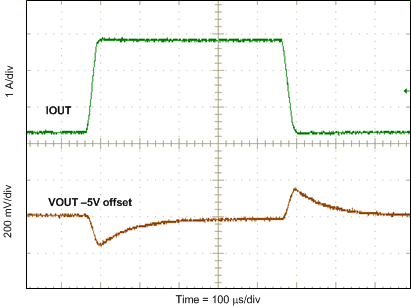 Figure 8-6 Load
Transient
Figure 8-6 Load
Transient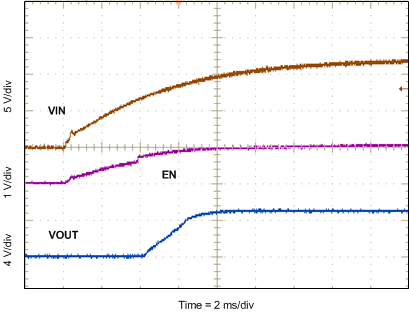 Figure 8-8 Start-up With VIN
Figure 8-8 Start-up With VIN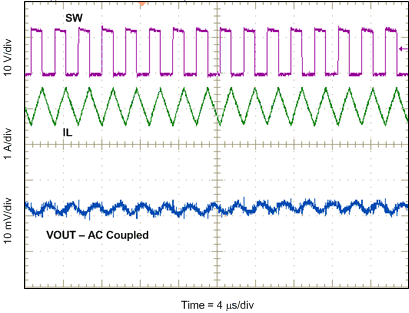 Figure 8-10 Output Ripple CCM
Figure 8-10 Output Ripple CCM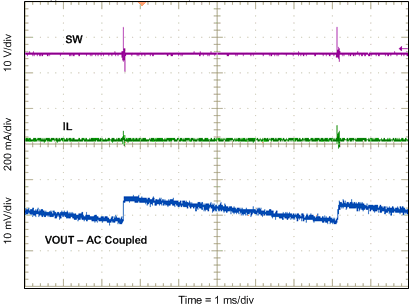 Figure 8-12 Output Ripple PSM
Figure 8-12 Output Ripple PSM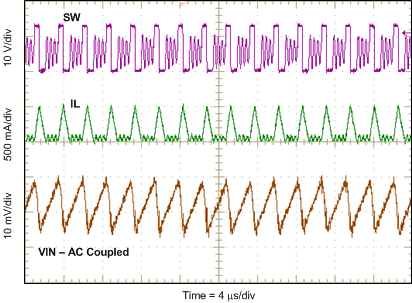 Figure 8-14 Input
Ripple DCM
Figure 8-14 Input
Ripple DCM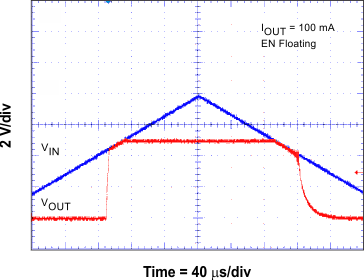 Figure 8-16 Low
Dropout Operation
Figure 8-16 Low
Dropout Operation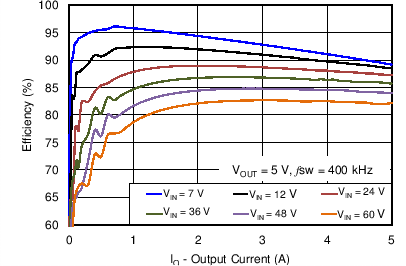 Figure 8-18 Efficiency vs Load Current
Figure 8-18 Efficiency vs Load Current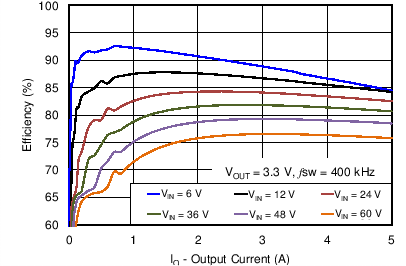 Figure 8-20 Efficiency vs Load Current
Figure 8-20 Efficiency vs Load Current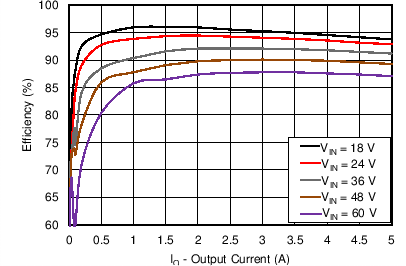
| VOUT = 12 V | fsw = 800 kHz |
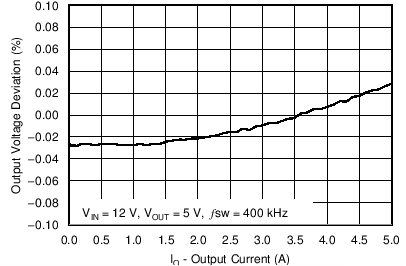 Figure 8-24 Regulation vs Load Current
Figure 8-24 Regulation vs Load Current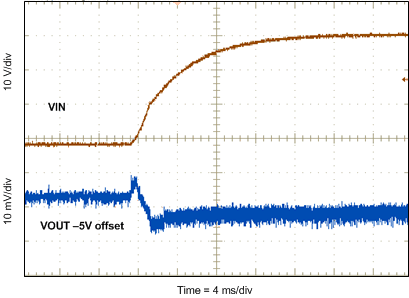 Figure 8-7 Line
Transient (8 V to 40 V)
Figure 8-7 Line
Transient (8 V to 40 V)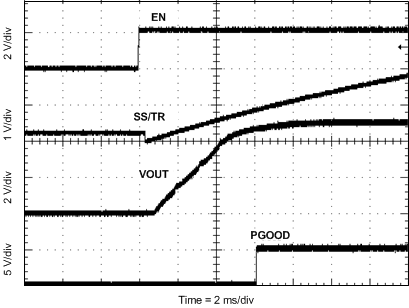 Figure 8-9 Start-up With EN
Figure 8-9 Start-up With EN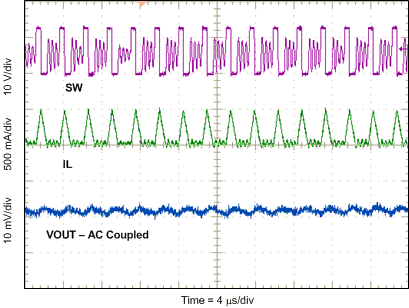 Figure 8-11 Output Ripple DCM
Figure 8-11 Output Ripple DCM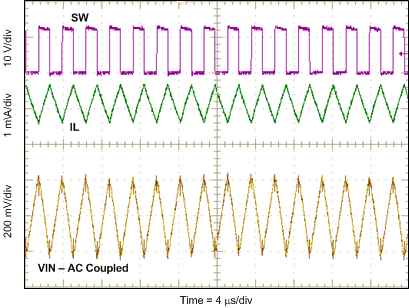 Figure 8-13 Input
Ripple CCM
Figure 8-13 Input
Ripple CCM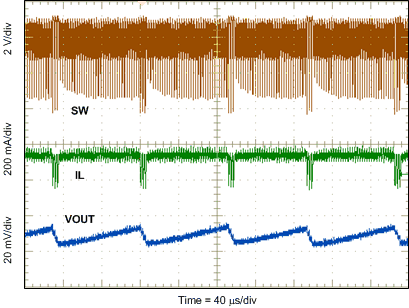 Figure 8-15 Low
Dropout Operation
Figure 8-15 Low
Dropout Operation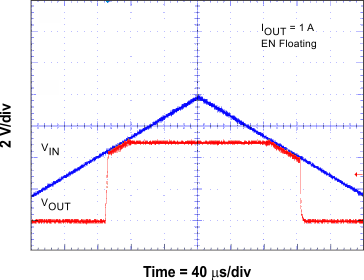 Figure 8-17 Low
Dropout Operation
Figure 8-17 Low
Dropout Operation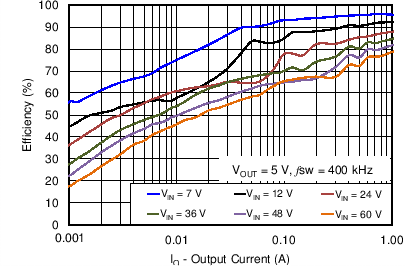 Figure 8-19 Light
Load Efficiency
Figure 8-19 Light
Load Efficiency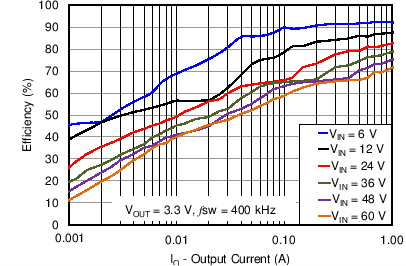 Figure 8-21 Light
Load Efficiency
Figure 8-21 Light
Load Efficiency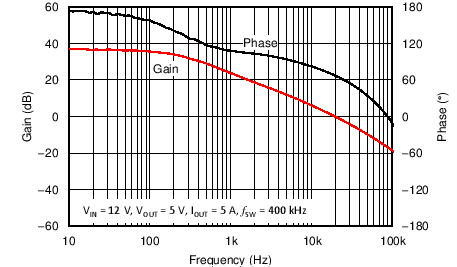 Figure 8-23 Overall Loop Frequency Response
Figure 8-23 Overall Loop Frequency Response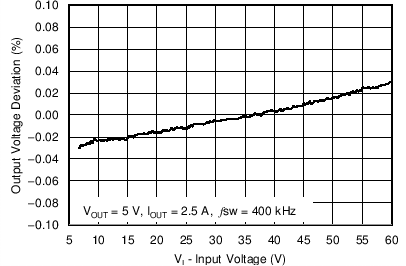 Figure 8-25 Regulation vs Input Voltage
Figure 8-25 Regulation vs Input Voltage